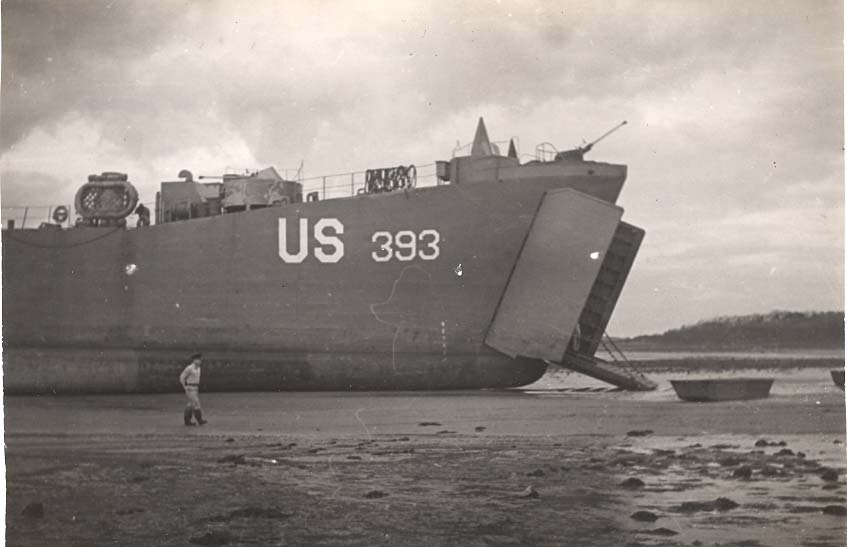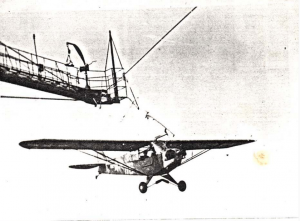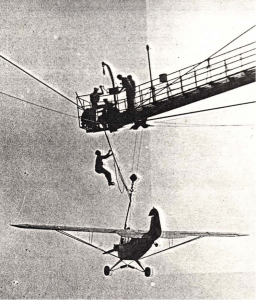
The LST, or Landing Ship Tank, is a seafaring vessel designed, developed and manufactured during World War 2, after England requested that the Americans create a vessel that could transport large amounts of troops and vehicles across channels and other bodies of water. The LST 393 was one of about 1,000 of these ships made. What made these large ships special, at least in regards to the many other kinds of transport ships that already existed, were the large bow doors. These doors could swing open exposing the interior of the ship, an allowing any of the cargo to roll right out of the ship and onto whatever beach they may have found themselves at. This design allowed the LSTs to move right up to the beach so things like tanks and Jeeps could land immediately onto the beach, without having to move onto a smaller ship and reach the beach.
LSTs were manufactured in shipyards located along inland rivers and on the great lakes. LST 393 was laid down on July 27, 1942 at the Newport News Shipbuilding & Drydock Co. and was launched on November 11, 1942. LST 393 was ultimately commissioned on December 11 of the same year with Lt. John H. Halifax, USNR in command.
This LST in particular was rather special in its design. Of the over 1,000 LSTs manufactured only a handful of them were able to carry airplanes, the LST 393 was one of them. While this might seem just a bit strange, being that these are called Landing Ship Tank, it does make sense. When these ships were commissioned the idea was to have a ship that could transport any kind of military supplies. This included things like troops, tanks, supplies, and even airplanes. The purpose of a plane on the LSTs served as spotter, making sure that during their many trips across places like the English Channel were clear from enemy U-Boats. Because the ship was definitely not long enough to serve as an airstrip for planes, like an aircraft carrier, the designers had to get a little bit creative. What resulted was a wire that ran from bow to stern of the ship and the small spotter plane was able to take off and land using a snare pole. The pictures below illustrate the process by which the plane takes off, lands, and is stored.
 LST 393’s rigging catching a plane LST 393’s rigging catching a plane |
 Crew hands on LST 393 working on plane rigging Crew hands on LST 393 working on plane rigging |
European Operations
After being tested and shipped out, LSTs were sent to various theaters around the world to places like Attu, Rendova, Sicily, Kiska, Munda, and New Guinea. The LSTs were useful in both the European and Pacific theaters. As amphibious warfare became more prevalent as the war moved on and more amphibious invasion took place in both theaters the LSTs found more and more use. The LST 393 was sent to the European Theater where it participated in the Sicilian occupation, the Salerno landings, and the Invasion of Normandy. For these three operations she received battle stars.
The first of the three major offences that LST 393 was involved in was the invasion of Sicily on July 10, 1943. During this invasion Allied troops landed thousands of troops across 105 miles of beach on the island of Sicily. This constituted the largest of the amphibious invasions in terms of length of beachhead and number of divisions landed on the initial day of the invasion. The Italian forces did not anticipate such a large invasion that the landings themselves were rather anti-climactic, but problems did arise when troops moved inward on the island. While the 393 made it through this particular operation unharmed, her sister ship LST-313 was sunk due to the Axis air operations during the invasion. 393 earned the first of her battle stars for her participation in the invasion.
The second offence that LST-393 was involved in was the landings in Salerno. September of 1943 saw the allies moving to the Italian peninsula. To do this they needed to once again mount an amphibious assault, which called upon LST-393. On September 9, 1943 the Allies attempted a surprise attack on the Italian city of Salerno. To achieve surprise the Allies began the assault with no preliminary aerial or naval bombardment, similar to the beginning of their Sicilian invasion. Unfortunately their surprise attack was less of a surprise then the Allies might have hoped. As the first division approached the shore a loudspeaker declared in English, “Come on in and give up. We have you covered.” The Allies continued their advance and landed anyway. By the 16th of September, the Axis troops withdrew and the Allies secured their victory and their beach head in Italy. The LST-393 received the second of her three battle stars here.
The invasion of Normandy, otherwise known as Operation Overlord, or D-Day was the Allied push into Nazi occupied France. This gambit, was what would secure the Allies presence in mainland Europe in ways that their presence in Italy could not. This operation was a huge undertaking, thousands of ships, troops, planes, tanks, and anything else you can think of was involved in the landing that took place on June 6, 1944. The naval force involved in the landings was massive about 7,000 vessels were present with about 4,000 landing craft. By the end of the invasion on June 11, 5 days after the operation began about 325,000 troops, 55,000 vehicles and 105,000 tons of supplies had found their way to the beachhead. This was just during one operation over 6 days.
Not many vessels were as important as the LSTs during the Invasion of Normandy. Their unique design allowed the ships to move right up to the beach, open the bow doors and allow the tanks and troops to roll out and straight onto the beach. By allowing the tanks immediate access to the beach head fewer were lost on the way to the beach as would have been otherwise. The 393 was part of the Omaha beach landing.
Unlike her service during the invasion of Sicily and the landings in Salerno, 393s actions during Operation Overlord were well documented. This may have to do with D-Day being one of the more important and ambitious operations during the whole of WWII. From an amphibious action report sent to the commander in chief, which mentions the actions of the many LSTs that took part in the Omaha beachhead, to the war diary that a crew member of the 393 kept, 393s actions during this time were not lost.
In The Report of Amphibious Operations, the writer mentions LSTs that made continual landings on Omaha beach in the afternoon of D-Day. While this report doesn’t specifically mention the LST-393, a diary kept by one of the crew member of the ship mentions these trips and their initial involvement in the operation.
Starting on June 5 they were anchored in Falmouth Harbor, Falmouth, England when they were signaled to form in a convoy of Task Group 126. A later entry on June 7th reports that they were part of a convoy carrying army vehicles and army personnel from Falmouth to Colleville, France. They arrived at Fox Green section of the Omaha beachhead where they unloaded their cargo and brought aboard casualties. On the 8th they came under fire from enemy planes overhead. They moved in closer to the beach, where they waited for the enemy planes to clear. They took aboard more casualties and formed in a convoy to head back to Portland, England. By June 13 they were headed back to the Omaha beachhead, this time they anchored off the Sugar Red section of the beach. This diary continues on talking in relative detail about the various round trips from England to beach heads on the Omaha beach in France. The final entry is marked on the 23rd of June, not because the ship came upon some terrible fate, but simple because that was the end of the diary. Whether the crew stopped writing or the rest is simple lost to time, is unknown. For 393s 18 days of operation in Operation Overlord she received the 3rd of her battle stars.
After 393 ended operations in France late in 1944, she was ordered to return home to be refitted to begin operations in the Pacific theater. While in for repairs and refitting she was painted in a tropical camouflage. As she was making her way down to the Panama Canal to help in the planned Japanese invasion, the Atomic bombs were dropped on Japan and the war was declared over.
The LST 393 over her career as a U.S. Navy service vessel over 9,000 troops found their way to the front, as well as about 3,200 vehicles.These vehicles include Long Tom Howitzers to simple Jeeps. LST 393 logged over 50,000 nautical miles over the 4 years of her military service during those 50,000 nautical miles she found herself at foreign shore 75 time. In addition to the troops she carried to battle, she carried over 5,000 prisoners of war and almost 1000 casualties.
Each of the three major operations that 393 was involved in were massive amphibious and aerial assault. While that might seem obvious, given that the USS LST-393 is naval ship, this was indicative of the kind of war that was becoming successful. Before WWII, wars were mainly fought on land entirely, without much regard for air or naval power. This could be because of more advanced technology in both aviation and naval sectors. But this also says that the way wars were though about was changing and the 393 and the other LSTs helped make it clear, that large amphibious assaults were possible. Because of the efforts of the LSTs and other ships in the same class, the Allies were able to move massive amounts of troops, vehicles and supplies to and from the battlefields where they were needed.
After WWII
Although nicknamed “Large Slow Targets” by crew members only 26, of the roughly 1000 LSTs were actually lost to enemy actions. After World War 2 more than half were scrapped, the rest were either sold for commercial use, or were sold to foreign governments. The LST 393 was decommissioned on March 1st 1946. The LST 393 was fortunate enough to be saved from being scrapped or sold to a foreign government, and found itself in the hands of Sand Products Corp., in Detroit, Michigan. Here it was converted for commercial service.
.jpg)
For many years the LST 393, now renamed the M/V Highway 16, carried automobiles from Muskegon, Michigan to Milwaukee, Wisconsin. The name comes from the now defunct US Route 16 from Detroit to Muskegon, as the ship “continued” the route over the lake. After many years of service carrying automobiles across Lake Michigan LST 393 was finally retired and turned into a museum in 2000. Initial efforts to restore the ship to its former glory were met with failure and after two years the effort was abandoned. However in 2005 with help from the owners, Sand Products Corp., efforts once again were resumed, this time however they proved successful. After years the ship was painted and restored and the bow doors, which had been welded shut in the late 40’s were once again opened.
Now the restored USS LST 393 sits in the Muskegon Lake in Muskegon Michigan where she serves as a museum for the public. Unfortunately LST 393 is one of only two LSTs that remain in their original configuration, the rest being fitted for commercial use, as the LST 393 was previously, or were scrapped years ago.
Primary Sources
- LST 393. LST Plane Rigging. 1943
- Anon. USS LST 393 War Diary, June 1944.
- Walter Bedell Smith Collection of World War II Documents, Box 48, Amphibious Operations Invasion of Northern France – Western Task Force June 1944; NAID #12005066
Secondary Sources
- Landing Ship Opens Jaws To Let Out Fighting Men. (1943, October 16).The Science News-Letter, 255-255.
- LST 393 – LST History (LST 393 – LST History)
- LST 393 – LST 393 History (LST 393 – LST 393)
- Naval History and Heritage Command (LST-393)
- D-Day and the Battle of Normandy: Your Questions Answered (D-Day Museum and Overlord Embroidery)
